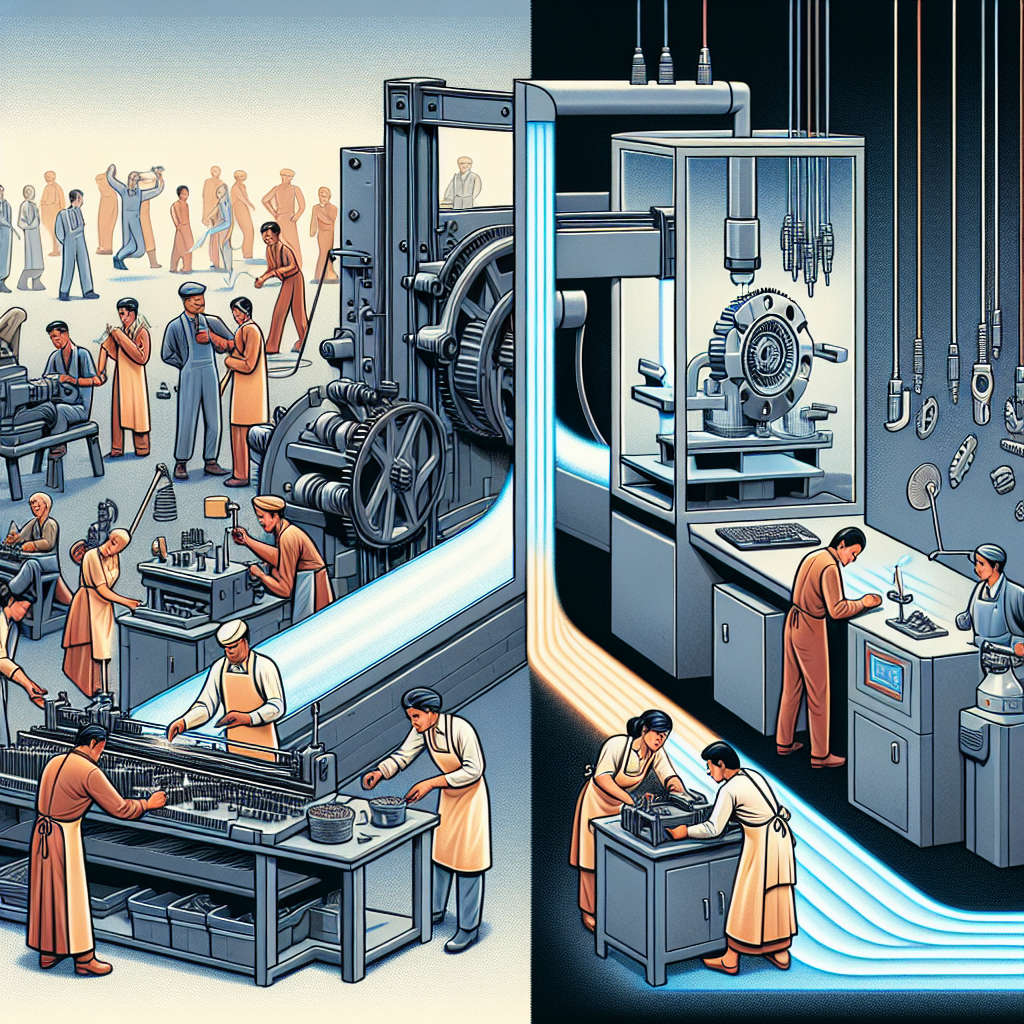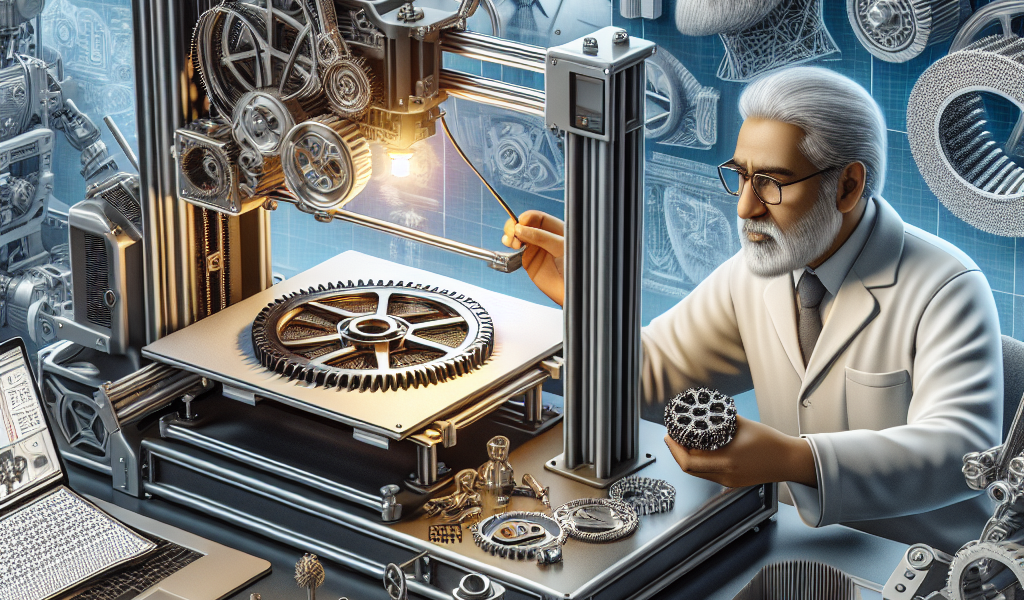-
Table of Contents
“Transforming Ideas into Reality: The 3D Printing Revolution in Manufacturing”
Introduction

3D printing, also known as additive manufacturing, is revolutionizing the manufacturing industry by enabling unprecedented levels of customization, reducing production costs, and accelerating time-to-market for new products. This transformative technology allows for the creation of complex geometries and intricate designs that were previously impossible or prohibitively expensive to produce using traditional manufacturing methods. By building objects layer by layer from digital models, 3D printing minimizes material waste and offers significant environmental benefits. Additionally, it empowers manufacturers to produce small batches or even single units economically, fostering innovation and facilitating rapid prototyping. As 3D printing continues to advance, it is poised to reshape various sectors, from aerospace and automotive to healthcare and consumer goods, driving a new era of efficiency and creativity in manufacturing.
Advancements In 3D Printing Materials
The advent of 3D printing has undeniably transformed the landscape of manufacturing, offering unprecedented flexibility and efficiency. Central to this revolution are the advancements in 3D printing materials, which have expanded the possibilities of what can be created. Initially, 3D printing was limited to simple plastics, but recent innovations have introduced a plethora of new materials, each with unique properties that cater to diverse industrial needs.
One of the most significant breakthroughs in 3D printing materials is the development of high-performance polymers. These advanced plastics, such as PEEK (polyether ether ketone) and PEI (polyetherimide), exhibit exceptional strength, heat resistance, and chemical stability. Consequently, they are increasingly being used in aerospace, automotive, and medical industries, where durability and reliability are paramount. The ability to print with these materials has enabled manufacturers to produce complex, lightweight components that were previously impossible or prohibitively expensive to fabricate using traditional methods.
In addition to high-performance polymers, the introduction of metal 3D printing has been a game-changer. Metals such as titanium, stainless steel, and aluminum can now be printed with remarkable precision, opening up new avenues for manufacturing. This capability is particularly beneficial for industries that require custom, high-strength parts, such as aerospace and defense. The ability to print metal components on-demand reduces lead times and minimizes waste, as parts can be produced directly from digital designs without the need for extensive tooling.
Moreover, the development of composite materials has further expanded the horizons of 3D printing. Composites, which combine two or more distinct materials to create a product with enhanced properties, are now being used to print parts that are both strong and lightweight. For instance, carbon fiber-reinforced polymers offer exceptional strength-to-weight ratios, making them ideal for applications in the automotive and sports equipment industries. The versatility of composite materials allows manufacturers to tailor the properties of their products to meet specific requirements, thereby enhancing performance and efficiency.
Another noteworthy advancement is the emergence of biocompatible materials for medical applications. These materials, which include biopolymers and bio-inks, can be used to print custom implants, prosthetics, and even tissue scaffolds. The ability to create patient-specific medical devices not only improves the fit and function of these products but also reduces the risk of complications. Furthermore, the potential for 3D printing to produce complex tissue structures holds promise for future developments in regenerative medicine and organ transplantation.
Sustainability is also a driving force behind the evolution of 3D printing materials. Researchers are exploring the use of recycled plastics and biodegradable materials to reduce the environmental impact of manufacturing. For example, polylactic acid (PLA), a biodegradable polymer derived from renewable resources like corn starch, is gaining popularity as an eco-friendly alternative to traditional plastics. The adoption of sustainable materials in 3D printing aligns with the growing emphasis on environmental responsibility and resource conservation in the manufacturing sector.
In conclusion, the advancements in 3D printing materials have significantly broadened the scope of what can be achieved with this technology. From high-performance polymers and metals to composites and biocompatible materials, the diversity of available options is driving innovation across various industries. As research and development continue to push the boundaries of material science, the potential for 3D printing to revolutionize manufacturing becomes increasingly evident. The ongoing evolution of 3D printing materials not only enhances the capabilities of this transformative technology but also paves the way for a more efficient, sustainable, and customized approach to production.
Customization And Personalization In Manufacturing
The advent of 3D printing technology has ushered in a new era of customization and personalization in manufacturing, fundamentally altering the landscape of production. This innovative technology, also known as additive manufacturing, allows for the creation of complex and intricate designs that were previously impossible or prohibitively expensive to produce using traditional methods. As a result, manufacturers are now able to offer highly customized products tailored to the specific needs and preferences of individual customers, thereby enhancing consumer satisfaction and driving market growth.
One of the most significant advantages of 3D printing is its ability to produce one-of-a-kind items with relative ease. Unlike conventional manufacturing processes, which often require expensive molds and tooling, 3D printing builds objects layer by layer from digital models. This eliminates the need for costly setup and enables rapid prototyping, allowing designers to iterate and refine their creations quickly. Consequently, businesses can respond more swiftly to market demands and consumer trends, offering bespoke products that cater to niche markets and individual tastes.
Moreover, 3D printing facilitates mass customization, where products can be tailored to meet the specific requirements of each customer while still being produced on a large scale. This is particularly evident in industries such as healthcare, where personalized medical devices and implants can be created to fit the unique anatomy of each patient. For instance, custom prosthetics and orthotics can be designed and manufactured to provide a perfect fit, improving comfort and functionality for the wearer. Similarly, dental professionals can use 3D printing to produce custom aligners and crowns, enhancing the precision and effectiveness of treatments.
In addition to healthcare, the fashion and consumer goods sectors are also reaping the benefits of 3D printing. Designers can now experiment with intricate patterns and structures that were previously unattainable, pushing the boundaries of creativity and innovation. Customizable footwear, eyewear, and jewelry are becoming increasingly popular, allowing consumers to express their individuality through personalized accessories. This shift towards customization is not only meeting the growing demand for unique products but also fostering a deeper connection between brands and their customers.
Furthermore, 3D printing is contributing to sustainability in manufacturing by reducing waste and optimizing resource use. Traditional manufacturing methods often result in significant material wastage, as excess material is trimmed away during the production process. In contrast, additive manufacturing uses only the necessary amount of material to build an object, minimizing waste and conserving resources. This efficiency is particularly beneficial in industries that rely on expensive or scarce materials, such as aerospace and automotive manufacturing.
Despite its numerous advantages, the widespread adoption of 3D printing in manufacturing is not without challenges. Issues such as the high cost of 3D printers, limited material options, and the need for specialized skills and knowledge can pose barriers to entry for some businesses. However, as technology continues to advance and become more accessible, these obstacles are likely to diminish, paving the way for even greater integration of 3D printing in the manufacturing sector.
In conclusion, 3D printing is revolutionizing manufacturing by enabling unprecedented levels of customization and personalization. This transformative technology is empowering businesses to create tailored products that meet the unique needs and preferences of individual customers, driving innovation and enhancing consumer satisfaction. As 3D printing continues to evolve and overcome existing challenges, its impact on the manufacturing industry is poised to grow, heralding a new era of personalized production.
Reducing Waste And Increasing Efficiency
The advent of 3D printing technology has ushered in a new era in manufacturing, characterized by significant reductions in waste and remarkable increases in efficiency. This transformative technology, also known as additive manufacturing, constructs objects layer by layer from digital models, offering a stark contrast to traditional subtractive manufacturing methods that often involve cutting away excess material. As industries worldwide grapple with the dual challenges of sustainability and cost-effectiveness, 3D printing emerges as a potent solution, reshaping the manufacturing landscape in profound ways.
One of the most compelling advantages of 3D printing is its ability to minimize material waste. Traditional manufacturing processes, such as machining and milling, typically result in substantial material loss, as excess material is removed to achieve the desired shape. In contrast, 3D printing uses only the material necessary to build the object, layer by layer, thereby significantly reducing waste. This efficiency is particularly beneficial in industries that utilize expensive or rare materials, such as aerospace and medical device manufacturing, where every gram of material saved translates into considerable cost savings.
Moreover, 3D printing enhances efficiency by streamlining the production process. Traditional manufacturing often involves multiple steps, including prototyping, tooling, and assembly, each of which can be time-consuming and costly. 3D printing, however, can produce complex geometries and intricate designs in a single step, eliminating the need for separate parts and reducing assembly time. This capability not only accelerates the production timeline but also allows for rapid prototyping and iterative design, enabling manufacturers to quickly test and refine their products. Consequently, companies can bring their products to market faster, gaining a competitive edge in an increasingly fast-paced global economy.
In addition to reducing waste and increasing efficiency, 3D printing also offers unparalleled customization and flexibility. Traditional manufacturing methods often require significant retooling and setup changes to accommodate different designs, which can be both time-consuming and costly. In contrast, 3D printing allows for easy customization without the need for extensive retooling. Manufacturers can produce small batches of customized products or even one-off items with minimal additional cost, catering to the growing demand for personalized products. This flexibility is particularly advantageous in industries such as healthcare, where customized medical implants and prosthetics can be tailored to the specific needs of individual patients, improving outcomes and enhancing quality of life.
Furthermore, 3D printing contributes to sustainability by enabling localized production. Traditional manufacturing often relies on global supply chains, which can be vulnerable to disruptions and contribute to significant carbon emissions due to transportation. By allowing for on-demand production closer to the point of use, 3D printing reduces the need for extensive shipping and warehousing, thereby lowering the carbon footprint of manufacturing operations. This localized approach not only enhances supply chain resilience but also aligns with the growing emphasis on sustainable practices and environmental responsibility.
In conclusion, 3D printing is revolutionizing manufacturing by reducing waste, increasing efficiency, and offering unprecedented customization and flexibility. As industries continue to adopt and integrate this transformative technology, the benefits are becoming increasingly evident, driving a shift towards more sustainable and efficient manufacturing practices. The potential of 3D printing to reshape the manufacturing landscape is immense, promising a future where products are made faster, with less waste, and tailored to meet the unique needs of consumers and industries alike.
Rapid Prototyping And Product Development
The advent of 3D printing technology has ushered in a new era in the realm of manufacturing, particularly in the areas of rapid prototyping and product development. This transformative technology, also known as additive manufacturing, has significantly altered traditional manufacturing processes, offering unprecedented speed, flexibility, and cost-efficiency. As industries increasingly adopt 3D printing, the implications for product development are profound, reshaping how companies design, test, and bring new products to market.
One of the most notable advantages of 3D printing in rapid prototyping is its ability to drastically reduce the time required to develop a prototype. Traditional prototyping methods often involve complex and time-consuming processes, such as machining or molding, which can take weeks or even months. In contrast, 3D printing can produce a prototype in a matter of hours or days, depending on the complexity of the design. This accelerated timeline allows companies to iterate more quickly, testing and refining their designs with greater efficiency. Consequently, the product development cycle is shortened, enabling businesses to respond more swiftly to market demands and technological advancements.
Moreover, 3D printing offers unparalleled design flexibility, allowing for the creation of complex geometries that would be difficult or impossible to achieve with conventional manufacturing techniques. This capability is particularly beneficial in the early stages of product development, where designers and engineers can experiment with innovative shapes and structures without the constraints imposed by traditional methods. The ability to produce intricate and customized components on-demand not only enhances the creative process but also opens up new possibilities for product innovation.
In addition to speed and flexibility, 3D printing also presents significant cost advantages. Traditional prototyping often requires the production of molds or specialized tooling, which can be expensive and time-consuming to create. With 3D printing, these costs are largely eliminated, as the technology builds objects layer by layer directly from digital models. This reduction in tooling expenses is especially advantageous for small and medium-sized enterprises (SMEs), which may lack the financial resources to invest in costly prototyping equipment. By lowering the barriers to entry, 3D printing democratizes the product development process, enabling a wider range of companies to bring their ideas to fruition.
Furthermore, the iterative nature of 3D printing allows for continuous improvement and refinement of prototypes. Designers can quickly produce multiple versions of a prototype, testing different materials, structures, and functionalities to optimize the final product. This iterative approach not only enhances the quality and performance of the product but also reduces the risk of costly errors and design flaws. By identifying and addressing potential issues early in the development process, companies can avoid expensive rework and delays later on.
The impact of 3D printing on rapid prototyping and product development extends beyond individual companies to entire industries. Sectors such as aerospace, automotive, healthcare, and consumer goods are increasingly leveraging 3D printing to streamline their development processes and bring innovative products to market faster. For instance, in the aerospace industry, 3D printing is used to produce lightweight, high-performance components that meet stringent regulatory standards. In healthcare, the technology enables the creation of customized medical devices and implants tailored to individual patients’ needs.
In conclusion, 3D printing is revolutionizing manufacturing by transforming the way companies approach rapid prototyping and product development. Its ability to accelerate timelines, enhance design flexibility, reduce costs, and facilitate continuous improvement is driving significant advancements across various industries. As 3D printing technology continues to evolve, its impact on manufacturing is likely to grow, further reshaping the landscape of product development and innovation.
Conclusion
3D printing is revolutionizing manufacturing by enabling rapid prototyping, reducing waste, and allowing for highly customized production. It streamlines the design-to-production process, lowers costs, and enhances innovation by making it easier to create complex geometries that are difficult or impossible with traditional methods. This technology is transforming industries by improving efficiency, fostering creativity, and opening new possibilities for product development and manufacturing.





